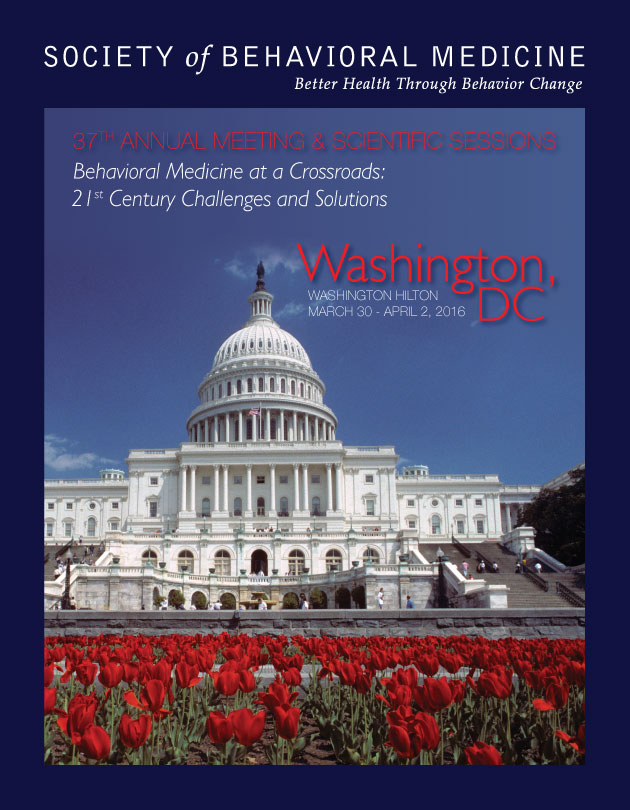
2015 Annual Meeting Stays True to National Prevention Strategy Theme
Lila J. Finney Rutten, PhD, MPH, Program Committee chair; and Kathleen Wolin, ScD, Program Committee co-chair
The stage was set for the Society of Behavioral Medicine's (SBM) 2015 Annual Meeting & Scientific Sessions with a thoughtful and inspiring opening keynote delivered by Minnesota Commissioner of Health Edward Ehlinger, PhD. Dr. Ehliger's keynote, with its attention to social and environmental determinants of health and its unwavering focus on health equity, brought into focus the fundamental components of the National Prevention Strategy, which served as the guiding framework for the 2015 meeting. The National Prevention Strategy identifies four strategic directions and seven targeted priorities for improving population health with clear relevance to the scientific efforts of the multidisciplinary membership of SBM. The strategic directions include creating and sustaining healthy and safe community environments that promote health and prevent disease; providing accessible and integrated clinical and community preventive services; providing the necessary tools and resources to support communities of empowered people; and improving health and quality of life for all through elimination of health disparities.
Throughout the meeting, the themes adopted from the strategic directions of the National Prevention Strategy resounded. Carol Naughton, JD, delivered a keynote describing the transformative impact of creating healthy and safe community environments. She spoke of empowering people and eliminating health disparities in Purpose Built Communities in Atlanta, GA. Raymond Baxter, PhD, in his stimulating keynote, described a vision for total health drawing on the groundbreaking efforts at Kaiser Permanente to integrate clinical and community preventive services, and to care for populations and communities. Judith Ockene, PhD, in her eloquent master lecture, also spoke to the evolving landscape in health care with a focus on the impact of the physician-patient relationship and integration of community and clinical care. Trissa Torres, PhD, continued this theme in her enthusiastic master lecture on movement toward greater clinical commitment to population health with payment reform; she offered inspiring examples of successful clinical-community partnerships. The closing keynote panel, chaired by Amelie Ramirez, PhD, highlighted the crucial role of communities in improving population health. The panel featured local speakers from community organizations committed to reducing the burden of obesity. Key priorities laid out in the National Prevention Strategy, including tobacco-free living, healthy eating, active living, and sexual health were integrated with cross-cutting themes identified in SBM's strategic plan throughout the program. For example, Bradford Hesse, PhD, gave a compelling master lecture on the role of big data in supporting population health research and improvement, offering intriguing opportunities for exploring novel methodologies in behavioral medicine. Margarita Lightfoot, PhD, in her energetic master lecture, described the emerging evidence base for use of technology to deliver behavior change interventions to prevent risky sexual behavior.
In her presidential keynote, Lisa Klesges, PhD, drew upon the ancient Greek conceptualizations of time—chronos and kairos—to fluently describe our collective journey in chronological time: chronos, to build an evidence base in behavioral medicine and to underscore the opportune moment in time, and kairos, before us as a professional society to have an impact on population health. The rigorous and significant science presented throughout the meeting in paper and poster sessions, symposia, roundtables, and seminars was worthy testimony to the progression of our professional society toward a readiness for the unparalleled opportunities to contribute meaningfully toward efforts to improve population health. As always, the networking offered at the meeting meant our members engaged in rigorous debate and asked thought-provoking questions of each other while meeting new attendees and sponsors. Both the accomplishments and opportunities for SBM were captured persuasively in Dr. Ehlinger's friendly "revision" to the SBM mission statement. He suggested it include greater recognition of the environmental, social, and political forces that shape health, and that it also include a specific aim toward health equity: "Dedicated to promoting the study of the interactions of behavior with biology, the environment, and the socioeconomic and political context, and then applying that knowledge to advance health equity and improve the health and well-being of individuals, families, communities, and populations."
The broad vision of this proposed amendment to the society's mission statement and the momentum of the 2015 Annual Meeting has carried over into planning for our 2016 Annual Meeting, to be held March 30 to April 2 in Washington, DC. The 2016 meeting, themed "Behavioral Medicine at a Crossroads: 21st Century Challenges and Solutions," will focus on behavioral medicine and behavioral health research to keep our field at the forefront of efforts to improve population health. The Program Committee has received excellent suggestions from the membership for content and is looking forward to the symposia, paper, and poster submissions to showcase SBM as a thought leader in this space.
